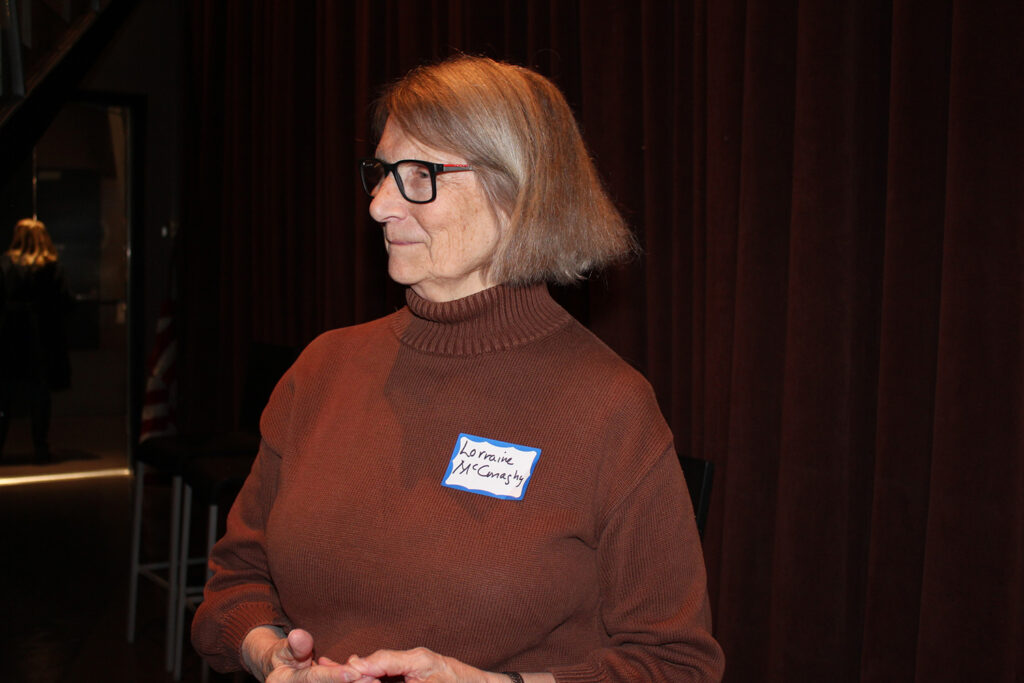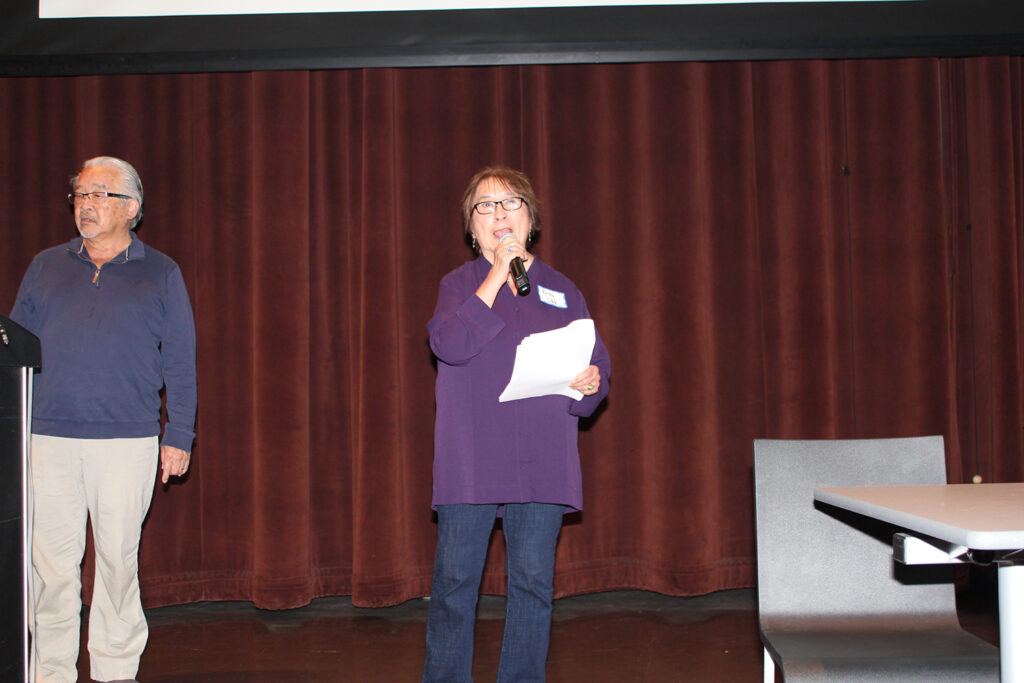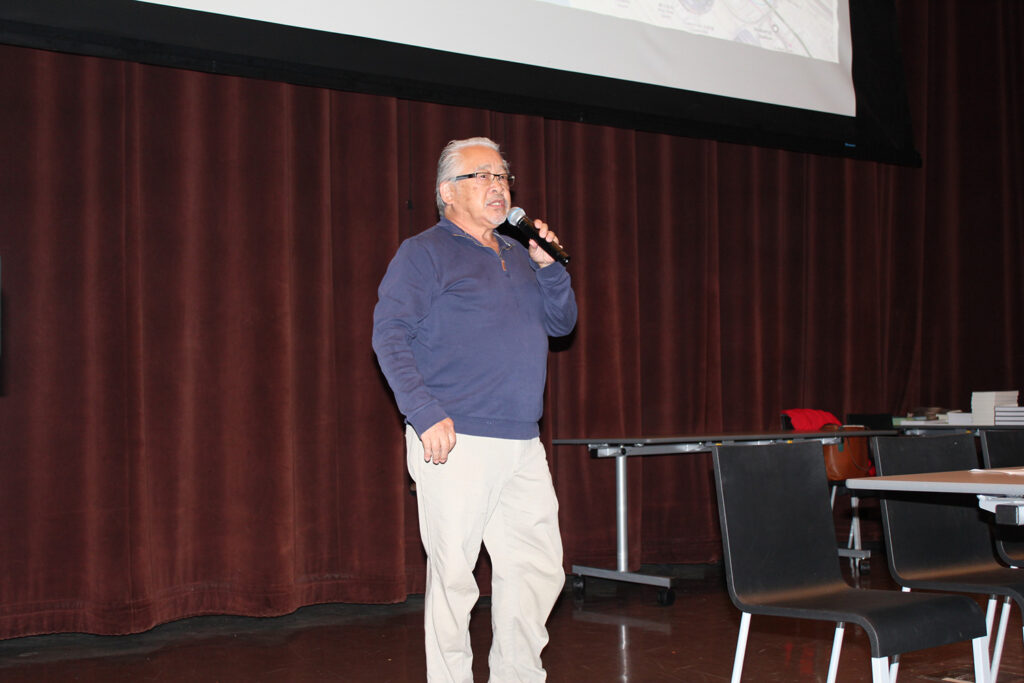By James Tabafunda
NORTHWEST ASIAN WEEKLY
Seattle’s Chinatown-International District (CID) stands at the center of public safety and other challenges. At the 32nd Regional History Conference, held Oct. 11 at Seattle’s Central Library, historians, educators, activists, and community members gathered to voice urgent concerns on the CID’s urban development, cultural preservation, and transit expansion.
The biennial event, organized by the Pacific Northwest Historians Guild and branded under the theme “Challenging History,” highlighted other, serious issues facing the CID.
This year’s event received sponsorship from the Seattle Public Library, the Washington State Historical Society, 4Culture, the Seattle Department of Neighborhoods, and HistoryLink.org, reflecting institutional concern about preserving Seattle’s diverse heritage.
Keynote on civil disagreement

Keynote speaker Lorraine McConaghy (Photo by James Tabafunda)
The event launched with keynote speaker Lorraine McConaghy, a prolific public historian, warning, “We are working in history at a time when we have lost the ability to engage in informed civil disagreement—the very heart of history and the very heart of democracy.” The remark set a somber tone for the conference’s breakout sessions—Tacoma Music History Project and South Asian Oral History Project, for example—that followed.
The weight of history; discrimination and displacement

Betty Lau (right) and Brien Chow (Photo by James Tabafunda)
Leonard Garfield, executive director of Museum of History and Industry, introduced Betty Lau, a retired teacher and leading CID advocate, as a leading figure in Seattle’s heritage struggles. Lau’s breakout session, “Saving Seattle Chinatown: Challenges,” examined how the district has endured repeated cycles of what she identified as three domains: political and legal discrimination, physical removal through urban development, and ongoing cultural erasure.
Lau cited the Chinese Exclusion Act of 1882, discriminatory burial practices redressed by the Chong Wa Benevolent Association, and sweeping city projects—interstate expansions, highways, and stadiums.
Her session drew from oral histories and family records to show how, after each wave of disruption, the community repeatedly rebuilt itself.
“Aside from the political and legal, there were the physical removals, most of it by Seattle downtown expansion or just expansion in general. ‘It’s just a bunch of Chinese. They can get out of the way,’” she quoted, exposing the indifference behind policy discussions.
“Chinatown used to be Fourth Avenue out to Dearborn (Street) … 40% of Chinatown was lost with I-5 … stadium construction had heavy impacts,” Lau said.
Ruby Chow’s legacy and neighborhood identity
Lau paid tribute to her mentor, Ruby Chow, who’s celebrated across Seattle’s Asian American heritage activism and local politics.
“Saving Chinatown through the decades was a lifetime’s work for Ruby Chow,” Lau said. “Our parents knew each other, worked together in the community, and I more or less grew up with the late Cheryl Chow under Auntie Ruby’s tutelage and became referred to as the daughter that Ruby never had because Cheryl had citywide interest. Mine was focused on Chinatown.”
The district’s struggle over its identity endures both in lived experience and official designation. “When you go to France, people say, ‘I’m French.’ They don’t say, ‘I’m pan-European.’” Lau recalled, pointing to decades of negotiations culminating in the contested 1999 recognition of the Chinatown-International District name. “What’s in a name? This is what Confucius had to say … you can’t get anything done unless you tell the truth,” she said.
Sound Transit expansion: A community at risk

Brien Chow (Photo by James Tabafunda)
The debate over Sound Transit’s expansion—whether to route light rail through or around the CID—took center stage for activists Lau and Brien Chow, a Transit Equity for All leader. Both argued that several proposed plans would either physically isolate or further harm Seattle’s historic district.
“Sound Transit is trying to basically demolish Chinatown,” Chow said. On the CID moniker, Chow stressed that residents are divided: “There’s three neighborhoods—Chinatown, Japantown, and Little Saigon. And please remember that the three neighborhood names are correct,” he reminded conference attendees.
Supporters of alternative transit schemes have put forth the “Fourth Avenue Super Hub” concept, suggesting it would bolster CID businesses and residents by centering more transit lines within the district and improving economic viability. Meanwhile, critics insist that Sound Transit’s preferred plans—the “North-South” and “Balducci” routes—would result in “isolating and dangerous transfers, with little benefit for the neighborhood.” Chow added, “That stop will only service that stop…you have to go to the surface and walk to the Chinatown station … because they’re running out of money and there’s a big, what, $30 billion overrun?”
Historic marginalization and national advocacy
Both Lau and Chow say that the stakes transcend city boundaries. “It is indefensible to put forth a plan that bypasses the same communities that have been historically marginalized and underserved … It is a racist, classist … attempt to disappear Chinatown and Japantown,” said a supporter cited by Lau. Their organizing efforts have garnered attention and assistance from the Washington State Trust and the National Trust, helping secure the CID’s spot on the National Trust’s 11 Most Endangered Historic Places list in 2023 and 2024.
Community defiance and strategic advocacy
Despite adversity, advocates cite the CID’s resilience and their ongoing alliances with preservation groups nationwide. These coalitions continue to press local agencies to ensure meaningful public engagement, especially for non-English-speaking elders and small business owners who have been overlooked in prior outreach efforts. Lau concluded, “Now our biggest challenge is Sound Transit,” urging continued activism and vigilance to protect the district’s future.
Community groups have sent letters to Sound Transit, staged protests, and presented demands to guarantee any station location sustains the CID’s economic lifeblood and visibility, refusing a repeat of history that saw minority-owned land and culture subject to external control.
Architectural legacy and living community
The conference also welcomed Alan Maskin, principal owner of Olson Kundig, internationally recognized for architectural projects including the Century Project at the Space Needle. Throughout the day, Maskin and fellow presenters noted that the story of the CID exemplifies the dynamic interaction between architectural legacy and cultural community. History, they maintained, is not static but vulnerable and in need of sustained, inclusive action and engagement.
Today the CID persists as a beacon of multicultural strength, home to intergenerational businesses, and rich annual festivals. Yet, with transit expansion approaching, the district faces a crossroads, uncertain whether it will continue to thrive or become unrecognizable under new development pressures.
The name “Chinatown-International District”
In discussing the district’s identity, Lau referenced Paul de Barros’ 1993 book, “Jackson Street After Hours: The Roots of Jazz in Seattle,” noting that historical “off-limits boundaries” near Jackson Street were a way to keep people of color out of white downtown Seattle.
“In my subsequent research, I found out really, it was to keep people of color from going into white downtown (Seattle), and that was the real purpose. Here’s a boundary,” Lau said. “The problem with ‘International’ is it permanently marks Asians as permanent foreigners. We’re Americans. We’re not ‘International’ but some people cling to ‘International’ saying it’s more inclusive. Well, then why isn’t Ballard ‘International?’”
The road ahead
The conference ended with a mix of hope and urgent warnings. Maskin and other presenters argued that the relationship between place, public memory, and living communities depends on more than just architectural preservation—it requires persistent advocacy and inclusive planning. Speakers repeatedly called for city leadership to listen more closely to elders, small business owners, and advocates who understand that transit decisions now will shape the CID’s fate for the many generations that will follow.
Civic leaders, historians, and advocates at the Central Library left the conference resolved to keep fighting—through public protest, official letters, and strategic planning—to ensure that Seattle’s CID survives the challenges ahead. For a district that is going through one major challenge after another, its fate may again hinge on diligence, coalition-building, and determined resistance to cultural erasure.

